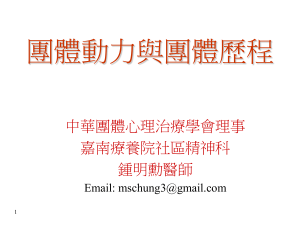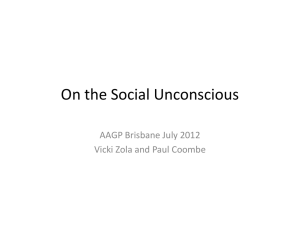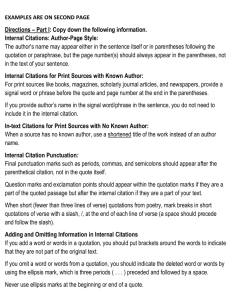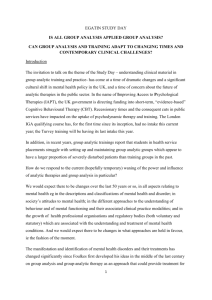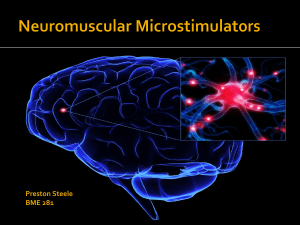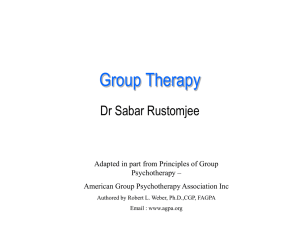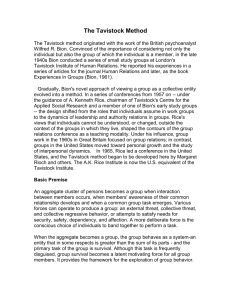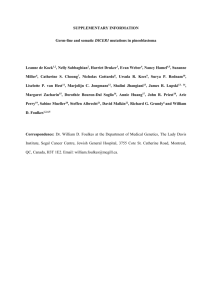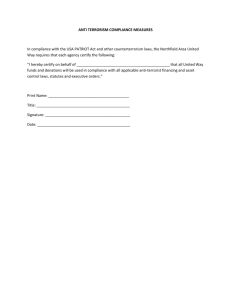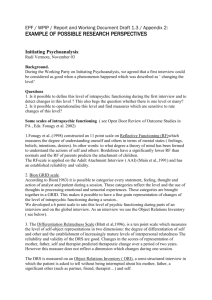HOW FOULKESIAN WAS BION
advertisement
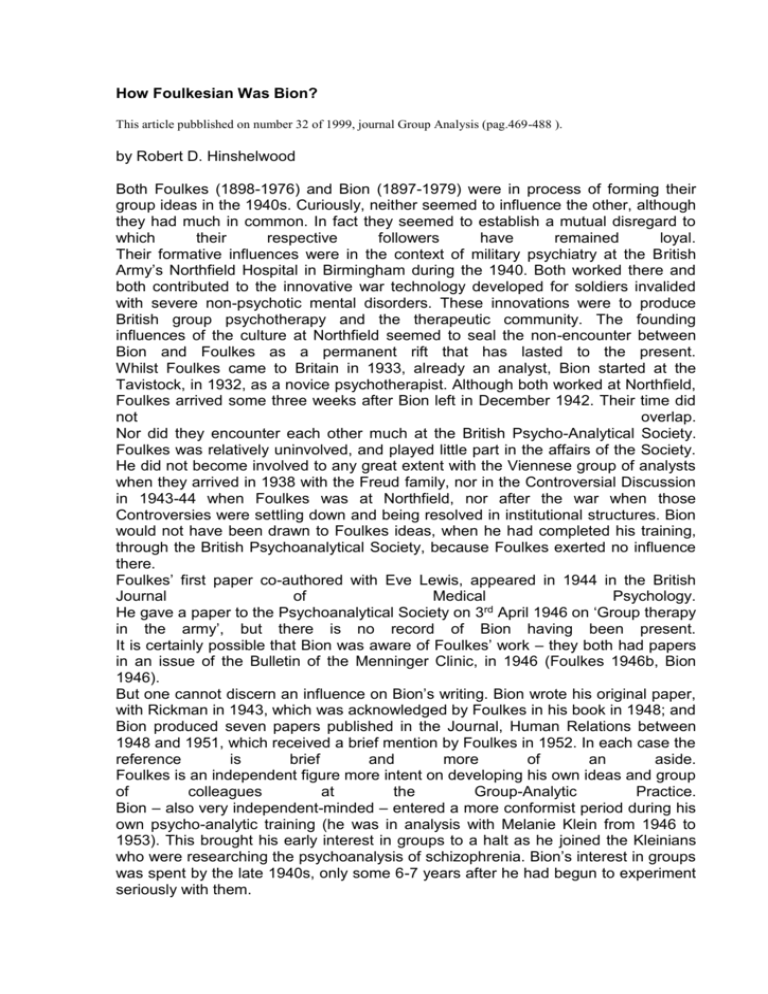
How Foulkesian Was Bion? This article pubblished on number 32 of 1999, journal Group Analysis (pag.469-488 ). by Robert D. Hinshelwood Both Foulkes (1898-1976) and Bion (1897-1979) were in process of forming their group ideas in the 1940s. Curiously, neither seemed to influence the other, although they had much in common. In fact they seemed to establish a mutual disregard to which their respective followers have remained loyal. Their formative influences were in the context of military psychiatry at the British Army’s Northfield Hospital in Birmingham during the 1940. Both worked there and both contributed to the innovative war technology developed for soldiers invalided with severe non-psychotic mental disorders. These innovations were to produce British group psychotherapy and the therapeutic community. The founding influences of the culture at Northfield seemed to seal the non-encounter between Bion and Foulkes as a permanent rift that has lasted to the present. Whilst Foulkes came to Britain in 1933, already an analyst, Bion started at the Tavistock, in 1932, as a novice psychotherapist. Although both worked at Northfield, Foulkes arrived some three weeks after Bion left in December 1942. Their time did not overlap. Nor did they encounter each other much at the British Psycho-Analytical Society. Foulkes was relatively uninvolved, and played little part in the affairs of the Society. He did not become involved to any great extent with the Viennese group of analysts when they arrived in 1938 with the Freud family, nor in the Controversial Discussion in 1943-44 when Foulkes was at Northfield, nor after the war when those Controversies were settling down and being resolved in institutional structures. Bion would not have been drawn to Foulkes ideas, when he had completed his training, through the British Psychoanalytical Society, because Foulkes exerted no influence there. Foulkes’ first paper co-authored with Eve Lewis, appeared in 1944 in the British Journal of Medical Psychology. He gave a paper to the Psychoanalytical Society on 3rd April 1946 on ‘Group therapy in the army’, but there is no record of Bion having been present. It is certainly possible that Bion was aware of Foulkes’ work – they both had papers in an issue of the Bulletin of the Menninger Clinic, in 1946 (Foulkes 1946b, Bion 1946). But one cannot discern an influence on Bion’s writing. Bion wrote his original paper, with Rickman in 1943, which was acknowledged by Foulkes in his book in 1948; and Bion produced seven papers published in the Journal, Human Relations between 1948 and 1951, which received a brief mention by Foulkes in 1952. In each case the reference is brief and more of an aside. Foulkes is an independent figure more intent on developing his own ideas and group of colleagues at the Group-Analytic Practice. Bion – also very independent-minded – entered a more conformist period during his own psycho-analytic training (he was in analysis with Melanie Klein from 1946 to 1953). This brought his early interest in groups to a halt as he joined the Kleinians who were researching the psychoanalysis of schizophrenia. Bion’s interest in groups was spent by the late 1940s, only some 6-7 years after he had begun to experiment seriously with them. In short, there is no evidence that Bion had a Foulkesian influence. In fact, if anything, the reverse; Foulkes may have been influenced by the climate of ideas he found at Northfield as Bion’s legacy. That near ‘near-miss’ confrontation at Northfield in 1942-43 is tantalising. For both, Northfield was a singular formative experience in group therapy, but they came with already divergent perspectives. Background influences Foulkes had trained in Vienna but worked briefly, before the Nazi ascendancy in Germany, in Frankfurt where he is said to have had some contact with the Frankfurt School of Social Research. How much Foulkes was influenced by their Marxism, I cannot judge, but he did have a definite interest in the sociology of Norbert Elias. Foulkes had been in the First world War, but in a non-combat role as a telephonist. Perhaps crucially he had first hand experience of the phenomenally successful group dynamics of the Nazi take-over of German culture. And in the early 1940s, he had begun the earliest group therapy in Britain (Foulkes and Lewis 1944). This latter experience enabled him to go to Northfield (between 1943 and 1946) as an authroity (at that time, as the authority) on group therapy. Bion was not interested in sociology but during the 1940s he was under the strong influence of John Rickman (his analyst between 1937 and 1939). Rickman was interested in social science and had done reconstruction work after the First World War, in Russia. His influence on Bion may have included notions of the collective picked up in Russia. Bion read history at Oxford, but had encountered group life early – at an English Boarding School when 8 years old. His experience in World War 1 was a military one and traumatic, as a tank commander when he was 21 (Bion 1997). Later he was a teacher at his old school, Bishops Stortford, before going on to medical school in order to train as a psychoanalyst. In 1942, Bion had been part of the influential experiment on officer selection at the War Office Selection Board (WOSB). He was still under Rickman’s influence and instigated with others the so-called ‘leaderless group project’ – not a therapeutic project. Briefly at the end of 1942, he worked at Northfield. The group-as-a whole Despite these very diverse experiences, these two pioneers had a common interest in applying psychoanalytic thinking to groups and group therapy. They also had a common starting point in academic psychology. I shall describe this starting point, before coming back to their very different ways of applying psychoanalysis. Both men jointly contributed the notion of the ‘group-as-a-whole’. How did they come to adhere to it? Where did they get it from? Are groups so obviously a single entity that they were bound to adopt it? No, that is not so. It was an idea that was simply in the air at the time. The 1920s and 1930s are the classic age of social psychology. For Foulkes and Bion the idea comes from German Gestalt psychology. In the 1880s Wilhem Wundt experimented on perception – notably vision – and this began psychology as an experimental discipline (Hearnshaw 1987). Wundt was struck by how the mind picks out a form or pattern (in German gestalt) from the background. That figure/ground (foreground/background) distinction was the core idea. And how the whole of the foreground/background operates as a single unit. We are familiar with this gestalt idea in common optical illusions. In the 1930s there were attempts to expand the gestalt idea, from the psychology of perception to social psychology. I shall mention two attempts. The first was Foulkes himself. He had dallied with becoming a psychologist in Germany before he trained as a psychoanalyst. He was particularly interested in the work of a neurologist, Kurt Goldstein, on neural networks in the brain. In his network theory of the brain, the individual neurones are nodal points set in the background complex of connections passing impulses between them. We can see how Foulkes simply transposed this to the concept of a communication matrix within a group in which the individuals are the nodal points set in the pattern of communications between them. The relation between individual and matrix corresponds to the foreground/background of the gestalt idea. The second attempt to use gestalt ideas as a social psychology is that of Kurt Lewin (1890-1947). He emigrated to the US at about the same time as Foulkes came to England. To my knowledge there was no contact between them. In the US, Lewin adopted the term ‘field’. The field is the whole social entity, described as a system of forces acting in an interpersonal space to move each individual into specific social roles and psychological states. In other words, social patterns of individuals are thrown up, as foreground, on the background play of forces (Lewin 1947a and b). Eric Trist, a psychologist at the Tavistock Clinic had travelled in the US in 1934, and brought back Lewin’s ‘field theory’. It influenced the Tavistock approach (Trist and Miller 1990) and Bion was one of those influenced. Lewin actually donated the term ‘group-as-a-whole’ – in his terms, it was the whole field of forces. We have the interesting situation then that both Bion and Foulkes were children of gestalt psychology; or perhaps grandchildren: Foulkes via Goldstein and Bion via Lewin. But the inheritances were divergent. Lewin’s ‘group-as-a-whole’ emphasised the social field of forces and Bion took that as the object of psychoanalytic study. Foulkes emphasised the pattern of communication processes and sought to encourage (facilitate) it, adopting the term, group-as-a-whole after Northfield – perhaps the main influence of Bion’s Tavistock tradition on Foulkes. Because of this major similarity, there is a need to explain their divergences and their mutual disregard of each other. Bion’s initial group ideas Bion’s group ideas began at the War Office where, together with Sutherland and Trist, he devised a group approach to officer selection (Murray 1990). Candidates for a commission were gathered together and asked to perform a task, as a group. Those who emerged as leaders within the group were regarded as the most suitable officer material. The groups employed practical tasks, which set people in a field of social forces under the pressures of which individuals moved into various positions of leadership – and followership. This was an entirely Lewinian application (Bion 1946). In the autumn of 1942, Bion worked with Rickman at Northfield (Bion and Rickman 1943), leaving in December. They applied a somewhat similar group concept approach to the rehabilitation wing, where soldiers were to be rehabilitated back to the army – as soldiers. They established, with a ruthless logic, that the field would be a military one. The forces in the rehabilitation wing should resemble those in a battalion at war – it was, Bion said, a ‘scallywag battalion’, in need of leadership to bring up morale. He regarded ‘good group spirit’ in the unit as comparable to emotional health in the individual. Bion took the role of leader who would bring his men to face the enemy. Having been a tank commander in the First World War, he did know what was involved in leading men towards an enemy. Then he determined what the enemy was. It was neurosis – an enemy that attacks morale. The men therefore joined battle against their common enemy, under the command of an experienced officer. That was the gripping idea. However, this was such a novel conception of a treatment that there were few outside the rehabilitation wing who grasped what was happening. And if they did grasp it they knew it was not a hospital regime that was being conducted. As is now well-known this ‘experiment’ was terminated by the hospital authorities after 6 weeks. Very quickly a new regime was instituted by those who came later. It is an irony that a regime that was modelled on the culture of the superordinate organisation, the army, was so ill at ease in a military hospital. Foulkes evolved idea Foulkes came to Northfield as a trained psychoanalyst in 1943. His first interest was in treating pathology. The legend is that in 1940 Foulkes had got together a number of his analytic patients into a single room, his waiting room, in a small street in Exeter, and invited them to do together what they did with him in the analytic sessions. This was to freeassociate. His approach was practical – to transfer a psychoanalytic form of practice into a group setting. He argued that if free association is the central plank of individual analysis then groups must do the equivalent, a ‘free-floating discussion’. This is a simple transposition, too, of Goldstein’s model of the communicating nerve network. Foulkes then followed classical psychoanalytic practice (as he had learned it in Vienna) encouraging that free-floating discussion. And, this is in line with the kind of psychoanalytic technique that he would have been taught around 1930. However technical, there is an incipient theory of group therapy here, which might go like this: Out of key with the group, the neurotic individual must be brought back into the communication matrix of free-floating discussion. This was not a conformist requirement on the individual to toe the line of group norms. It was a much more sophisticated theory, as I understand it. The individual needs to be brought into the group, not as a Mr Average, but as an individual who can express (communicate) his individuality better and more congenially within the context of the group. The figure/ground matrix was expressed thus: ‘in the group analytic situation the personal problem is in the foreground, the institutional aspect in the background, discussion is free-floating’ (Foulkes 1964, p. 270). The straightforward practical use of the gestalt idea was free-floating discussion. This led in a different direction from Bion’s group-as-a- whole, where, the gestalt idea is a group phenomenon (‘neurosis’, say, or ‘the leader’) as foreground against the background forces in the group field. The clash at Northfield Foulkes arrived in the aftermath of Bion’s military experiment with morale. He wanted to stamp a psychoanalytic approach on the place. His medical and psychoanalytic background was more consistent with the hospital regime, a system for the care of the individual. The contrast with Bion’s army regime which conceptualised treatment as the military task of creating a high morale, is pointed up by the apocryphal story that Foulkes started his groups with the injunction: ‘Whilst in the group we are not in the army’ (Tom Harrison, personal communication). Foulkes’ injunction makes the cultural clash explicit. Bion had challenged the hospital culture as a retreat from life for restful recuperation, And he had lost the challenge. His military regime made men subservient, a means to an end, that end being the efficiency and morale of the Unit. When Bion introduced this into the hospital setting at Northfield, he clashed with a culture which prioritised the health of the individual. The hospital inevitably found difficulty in accepting Bion’s regime. Tom Main, in his first Foulkes lecture (Main 1977), criticised Bion for his singleminded replay of such a war experience in the hospital. It was against the medical grain of a hospital. Main, who went to Northfield in 1945, also thought that Bion neglected the military authorities who were not at all keen on mere medics posturing in military ways. Thus Bion’s experiment – the so-called first Northfield experiment foundered quickly on this unaddressed problem, a clash of cultures. But Main approached the larger system of the whole hospital in the manner in which Bion approached the single unit, the Rehabilitation Wing. It is not true that Main’s views on the larger system, solved the problems of the first Northfield experiment, as Main (1978) seemed to imply. Rather it put the clash between what Bion and Foulkes separately represented, into a context. What Main learned from this lesson was to address the morale of the whole system, military and doctors together. As a Lt-Colonel, Main was a rank above Bion (and Foulkes) and had a wider hospital responsibility. This inevitably meant dealing with a large system that was one that contained the clash. So, though Bion and Rickman left Northfield, their ideas did not. The enduring clash is evident from a series of discussion seminars on group therapy held in 1945. Interestingly, we have the record of these weekly seminars (held in the Welcome Foundation Library: Contemporary Medical Archive Centre, PP/SHF/C.38). The Northfield treatment regimes In 1944 Foulkes moved from being a doctor in charge of a ward, to become a peripatetic group therapist (de Mare 1983), and in April 1945 set up a seminar at Northfield to discuss group therapy. The seminar ran from April to December, weekly for the first two months, then every 1-3 weeks, and petered out in the last two months of the year. About 15-16 members included most of the psychiatrists running groups in their wards. Detailed notes were kept on all 21 sessions except the first two. Group therapy was a very new field, when Foulkes introduced it at Northfield in 1944. Before then, the treatment regime consisted of two parts: individual interviews with the psychiatrist (sometimes called psychotherapy, and aimed at ‘insight’ into personal symptoms) and activity groups, in which work aimed to restore an experience of group morale to men who were potentially part of a fighting force. Foulkes instituted a new regime of three parts by adding verbal group therapy to the previous First Northfield experiment Rehabilitation ward run on moraleoriented social psychology lines Hospital regime Two-track treatment programme of: a. b. Second Northfield experiment insight-oriented individual therapy/interviews morale-oriented activity groups Three-track treatment programme of: a. b. c. insight-oriented individual therapy/interviews insight-oriented group therapy morale-oriented activity groups The activity groups had a great importance at Northfield. Harold Bridger was in charge of the activities section. He had also taken part in the WOSB use of groups in officer selection, and therefore had the same background as Bion and Rickman. He and Main sustained something of the thinking of the First Northfield experiment when the second one got going in 1944. His activity groups were not run by psychiatrists, but by instructors, and he regarded them not as medical work, but as something more like the army itself. The social relations were geared around the practice of some activity, aimed at realistic tasks, including a ‘social club’. Bridger was attempting to sustain the idea of a social field which individuals entered. They were subjected to various forces that came into play in the context of the activity, and later emerged with significantly modified social relations (hopefully permanently modified). In fact, Bridger had no experience of the medical or therapeutic world, having been a mathematics teacher before the warThere were therefore several tensions that were active at the time. The clash between the military regime and the hospital regime, was eventually mapped onto the clash between activity groups and verbal groups. The group therapy seminar discussions I shall now summarise my conclusions from a reading of the 100 plus pages of the transcript of the seminar discussions. The seminar participants seemed to come with several identifiable First, Foulkes, as leader of the seminar, wanted to do two things: aims. a. to bring up the quality of the group therapy conducted by people who had never done it before, and b. to establish a research culture enquiring into group therapy. Foulkes, who started the seminars and was the only one to have prior experience of group therapy, clearly aimed to stimulate their thinking, especially at a practical level. He did this with questions or with rather general comments designed to get the seminar members thinking, and to get them to fill in the details with their examples. There were many participants who were completely new and naïve and they appeared to be joining the staff at regular intervals during the course of the seminar. Foulkes took the position of an educator. His presence was very strong and discussion tended to revolve around his comments. There were others who refrained from taking up the position of naïve newcomer to groups – Bridger, Sutton, Main. There were some who, though new to it, soon became independent in their thinking – Dewar; and some with imaginative though provocative challenges – de Mare. Foulkes rarely responded to participants with their own independent views and seemed to direct his attention particularly to issues of difficulties in the practice. His approach rested on three kinds of intervention: One was to get the group therapists to be aware of themselves as having their own feelings, feelings which may set the style of their group; Second, was an interest in specific issues like selection for groups, consistency, dealing with negative attitudes in the group, or particularly towards the group, and impressions of outcome; Thirdly, he was keen to get the seminar members involved in each other’s groups – by sitting in with each other. In addition, he occasionally gave some examples of his own peripatetic work – including the now often-quoted incident in the group dynamics of the hospital danceband. Participants whose points of view contrasted with Foulkes’, were less good at engaging the thoughts of the group therapists – who in a sense became a kind of constituency to be woo-ed. One group of psychiatrists (Sutton seemed most vocal of them) remained occupied with individual therapy, but ran groups and wondered how a group could promote an individual’s insight into his individual symptoms. Sutton, for all his loyal attendance at the group retained his doubts to the end. Others often starting with these doubts about group therapy, moved on a bit under the influence of Foulkes’ confidence. Sutton’s position contrasted with Foulkes’ view that a person’s neurotic problems were expressed within the group relations, so Foulkes did not stress insight into symptoms but facilitated discussion. This teaching then provoked questions about the special place of the psychiatrist. Sutton and those loyal to an individual view of insight-giving therapy prioritised the psychiatrist as the key person to give insight, which the group would otherwise evade. Foulkes did a lot to undermine this view of therapy, particularly, and interestingly, by drawing attention to the psychiatrists’ countertransference feelings as indicating they were also simply ‘another group member’ relating to their groups. Foulkes indicated that therapy in a group was simply the expression and communication of a person’s experiences to his group colleagues. Another position was, at first, expressed by Bridger and more latterly, and more forcefully by Main. They did not attend the seminar to learn from Foulkes. They presented a different point of view, one which was rooted in the earlier experiments at Northfield. Their stress was on the importance of the ‘activity groups’ rather than the ‘verbal groups’, but they joined Foulkes’ in downgrading personal insight into symptoms and, like Foulkes’, led to discussions about neurosis as disturbed relationships – rather than as a discourse upon a symptom. However, the difference lay in the aim of a group. For Main, groups generate good morale, team spirit, cohesion and, he emphasised, the personal experience of ‘belonging’, and for him this meant the activity groups. Technically his aim was to create group cohesion and this led to discussion towards the end of the seminar series about ‘what is a group’ and ‘how is it different from a crowd’, or ‘a rabble’. Foulkes Bion 1 Individual in the matrix Group phenomenon in a field of forces 2 Primary interest therapeutic Non-therapeutic experience 3 Facilitating discussion free-flowing Insight foreground/background relationship 4 Caring culture Military culture 5 Individual-oriented Social (morale) orientation 6 Self-expressive communication Experience of belonging group into The contrasting aims implied different therapeutic agents in a group. Whereas Foulkes said it was expressive communication; Main said it was the experience of belonging. The seminar series never got down properly to an engaged discussion of the basic differences. Instead, Foulkes talked directly to the constituency of newcomers, about their anxieties and issues in practice. By doing so, he was much more successful than other participants with independent ideas, who wanted more fundamental debate. In addition, he was older and the one who could claim all the relevant experience. Those with independent views seemed to talk also to Foulkes as the central figure. Foulkes did not directly engage with their separate views making it difficult to achieve debate on basics – particularly about the nature of a group (as opposed to a crowd), or the nature of the therapeutic factors in a group. Foulkes unwillingness to engage with other views left them undermined but did not dispose of the tensions. This might be significant in terms of the gradual decline of the seminar over its nine months of life. The newcomers were pushed to take the floor because there was no real progress to be made in the real engagement between different views. But that decline might also be to do with other factors than unresolved tensions. There was a noticeable repetition in the topics discussed. Newcomers to the staff were confronted with the same anxious reactions to starting a novel form of therapeutic work, and brought their issues to the seminar. I have selected the evidence in these documents that a tension continued between two cultures. It is most vivid in a comment by Bridger (in Seminar session 3, April 26th) which I’ll quote. Foulkes had just responded to a direct request by a therapist for advice on how to handle a specific situation by querying if expert professional knowledge was useful, or if a handicap. He implied perhaps the group itself should be invited to handle the request. Bridger then used that comment to make a slightly different point; instead of Foulkes choice between being a professional expert, and allowing the group to reach its own solution, he said: This brings to mind by association, my own experience when discussing with Major Bion his own experiment at Northfield 2 years ago. If you remember, he dealt with the rehabilitation ward as an experienced psychiatrist and he was an experienced unit officer. When he asked for comments on his article I expressed the opinion that coming here to carry out my experiment I would not be the former. He implied a military officer was more appropriate than a psychiatrist. It seems to me that the tensions revealed in these discussions revolve around that question posed by Bridger: is the group leader a professional expert, or a military leader. Foulkes’ was occupied by quite a separate issue – the roles of expert helper, and of instigator of collective self-help. They were talking, literally, at cross purposes. What might these seminars have been like had Bion remained at Northfield? He, like Foulkes, created a strong presence in a group. He, too, had a style that aimed to get people thinking rather than to tell them what to think. And, both saw groups in research terms. However there is a profound difference between their aims. Foulkes tended to get people thinking about the details of therapeutic practice. He was a healer dedicated to create more healers. Bion, in contrast, had another aim. It was not to heal – not in a direct sense. He wanted the group members to assist in thinking about the group for themselves – it was an ontological research: What is the nature of a group? And what is the place of a human person within a group of other persons? Bion came to see this research, in itself, as having curative properties, as it would advance the maturity of the members of the group who undertook the research. Foulkes research was of a different order completely – simply to discover the therapeutic factors of a group. Research was therefore a seminar activity conducted away from the group. Members were not asked to engage in a philosophical endeavour of the kind Bion required. Foulkes required the group members to develop their capacity for expression, self-expression. Self-expression, and relatedness on that basis, was his curative agent. Bion Similarities Strong presence Getting group members to think themselves Group therapy as research Differences The nature of a ‘group The place of a person in a group Research by the group Foulkes Technical practice of group therapy Group expression Research on the group Conclusions The evidence suggests that Bion and Foulkes were caught as the representatives of two separate cultures that were hard to reconcile. Cultures and their representatives: Each person, no doubt, performed the role of representative for their own personal reasons, but it is simplistic to attribute their divergence merely to personal characteristics and variances. From a group dynamic point of view they were also pressed to represent opposing camps by an oppositional kind of culture that was prevalent at Northfield, in a time of war. Therefore, after the Hospital ejected the foreign body – the military culture of Bion and Rickman – that emphasis upon the health of the social unit, nevertheless, remained championed by some people. For instance, Main wrote in correspondence (letter to Rickman, September 1944 – Tom Harrison, personal communication) of his view that activity groups appear to have the most significant effect on the subjects. He dismisses the verbally based communication groups that Foulkes and his ‘set of disciples’ practised. Cultures clashing: The culture clash at Northfield is a common group process. We are reminded of a similar one at Scutari, the hospital in the Crimea. There, Florence Nightingale created a space for caring for soldiers (Woodham-Smith 1953), in the midst of the military mentality. She, too, found the two cultures uncongenial to each other. The emotional clash – caring versus murder and hate – became converted into a tension between separate group cultures, and she conducted a life-long campaign against the military attitude to medical provision. A group schism is supported by different sets of people who align themselves with one side or the other of an emotional divide. The cultures which clashed in our case, had several features caring versus military; or individual-oriented versus social; or active task versus reflective. Figure 5 formalises various components Two cultures military morale hospital care social orientation individual orientation active task reflective task belonging expression Figure 5 Subsequent developments: Northfield itself attempted to deal with the tensions in its staff discussion groups, but a number of those at Northfield, as well as Bion and Foulkes went on to careers that still bear traces of those tensions more than 50 years ago. Some attempted to bring the two sides together, some kept them strictly apart, and some kept them in a mediated tension. Bion did not stay long at Northfield and did not experience any of the attempts to heal the rift. Therefore we may not be surprised that the raw conflict between the military and caring cultures at Northfield comes through in his later descriptions. In Experiences in Groups (the collection of his papers from 1940s) he describes three basic assumptions (Bion 1961). Two of them – ‘dependency’ and ‘flight/flight’ (Bion 1947) – exactly correspond to the caring and military cultures of Northfield. As basic assumptions, he describes them strictly as alternating states of mind in the group members, states that are mutually exclusive of each other. Those at Northfield in its later years, experienced ways in which the alternative cultures co-existed. For instance, Bridger’s recent work on the ‘double-task’ idea, brings the two sides together – an activity task together with a reflective task, conducted jointly (Bridger 1987). The reflection on the activity, he claimed, was the basis of the therapeutic community idea (Bridger 1990). The active, or activity therapy was a profoundly important aspect of the new ideas at Northfield. It is surprising that Foulkes, and his subsequent followers eschewed the emphasis on physical work. In fact, the often noticed link between Foulkes and the Marxist Frankfurt School, in the 1930s led many to think Foulkes was influenced by them. But his blithe disinterest in physical work or the importance of the material basis of life suggest he was not greatly influenced by Marxism. Joshua Bierer, who in fact did not attend the discussion seminars, was also impressed by the activity groups. When in 1946 he went on to found the first psychiatric day treatment centre, the Marlborough Day Hospital, he staffed it with occupational therapists rather than nurses (Bierer 1951). From 1946 onwards, Main (1946) designed (with Bridger's encouragement), a therapeutic community which continued the early ‘two-treatment’ approach at Northfield. This was the Cassel Hospital where formal psychoanalytic psychotherapy and the ‘work of the day’ as it is called, run parallel with a constant monitoring of the tension between them (Griffiths and Pringle 1997). The Cassel is an almost complete transplant of the Northfield regime prior to Foulkes’ move to create group therapy there. It seems much more faithful to that original regime than I had realised when I was at the Cassel. The nursing staff, and the Matron Doreen Waddell taking the place of the activity groups and Harold Bridger. Of course, it is immensely elaborated now, but the outline blueprint is impressively identical. Each person had to come to terms with the clash of two cultures. Interestingly, Bion described, briefly, the nature of a group rent by schism (Bion 1961, p. 159). Previously I had thought this to be a reference to the divided nature of the British Psychoanalytical Society, in the 1940s when Bion first encountered it. But as a result of the current research, it seems that Northfield was a very stark (and perhaps bitter) preceding encounter with a culture clash. Diverging sub-cultures: I have described how the emotional clash – caring versus hating – became subverted into a tension between separate group cultures. Those groups then ‘enact’ the emotional tension as a political contest between them. The general notion of divergent sub-cultures is very helpful. Elizabeth Bott’s paper, ‘Hospital and society’ (Bott 1976), described the task of a mental hospital as divided between treating the patient and containing the disturbance. And the latter, containing the patient, was itself divided between custody (locking the disturbance away from family and the public) and asylum, or locking the world away from the patient. The point is that these aims conflict, and the unhealthy cultural problems arise, often unconsciously, when the institution tries to satisfy conflicting demands. One way out of conflicting aims leads the institution to divergent cultures, or subcultures. The idea of the unconscious division of cultures helps to understand the divergence between the cultures of general psychiatry and of psychotherapy in the NHS (Hinshelwood 1996). Each of those cultures holds different aspects of the overall task each polarises the other; psychiatrists to greater and greater objectivity as they carry the fear of relating to madness; whilst psychotherapists take an opposite approach, promoting relatedness (often highly unwelcome to psychotic patients), and thus carrying a human counterbalance to objective psychiatry. Another similar cultural divergence is in the prison system (Hinshelwood 1993). The dominant, male disciplinary officers polarise from the soft and denigrated minority groups of inmates and staff. The caricatured forms express the emotional clash between custody and care, which in reality needs to be integrated. Another cultural divergence, in the hospital service, is between the managerial culture versus the professional care culture. It would appear to solve an emotional conflict between needing resources to restore people from sickness versus the recognition that resources have a ceiling and rationing has to exclude certain people to die. Historical understanding: The question in my title has to be answered in the negative. Bion was not Foulkesian. Nevertheless, the development of Bion’s and Foulkes’ ideas is in the context of each other, polarising each other to some extent. And this occurs, I suggest, through the group dynamic effects, dealing with an emotional conflict inherent in the culture of origin – at Northfield. This is a historical, group dynamic thesis. Can we employ historical understanding to help us today with the legacies of Foulkes and Bion? In fact, it points to an emotional conflict in our field which has been ‘solved’ in the past by a group schism supported by different people aligned with one side or the other of the conflict. That contradiction - caring for people in the middle of a war – needs to be mediated, rather than split apart. Armed with such an understanding of the origins, we can at least be aware of the position we occupy today. The clash has a history and a narrative depth which I have indicated can be carried through to the present day. The divisions between Group-Analysis and the Bion/Tavistock tradition can be posed in personal or ideological terms, but that diverts us from the emotional tension that drove the ideas apart. Solving the tension by splitting into two sides impoverishes both sets of ideas. Each side loses a dimension. If we want to enrich our ideas, we must study the problems of holding together caring and hating, the individual and the social. We each need to face the difficult emotional significance of the issues of group therapy, and group life. We need to remember it is an easy option to go for one position or the other. We do that for comfort rather than for truth. We need to establish the tension as a creative one. If influences that drove Bion and Foulkes , and their followers, towards polarised positions are valid, it is important for us now to understand how we each position ourselves. If we are to follow Malcolm’s initial plan of ‘ongoing dialogues between Foulkesian and other group-as-a-whole approaches’, we must understand how we are gripped in a polarising dialectic by the history of our profession. Acknowledgements: This paper owes a great deal to Tom Harrison, Ben Shepherd and other members of the special seminar organised by Craig Fees of the Planned Environment Therapy Trust Archive. References Bierer, Joshua 1951 The Day Hospital: An Experiment in Social Psychiatry and Syntho-Analytic Psychotherapy. London: Avenue Press. Bion, W.R. 1946 The leaderless group project. Bulletin of the Menninger Clinic 10: 71-81. Bion, W.R. 1948-1951 Experiences in groups I-VII Human Relations 1: 314-20, 48796; Human Relations 2: 13-22, 295-303; Human Relations 3: 3-14, 395-402; Human Relations 4: 221-227 Bion, W.R. 1961 Experiences in Groups. London: Tavistock. Bion, W.R. 1997 War Memoirs. London: Karnac. Bion W.R. and Rickman, John 1943 Intra-group tensions in therapy: their study as a task of the group. Lancet 2, 27th Nov: 678-681 Bion, W.R. 1948-1951 Experiences in groups I-VII Human Relations 1: 314-20, 48796; Human Relations 2: 13-22, 295-303; Human Relations 3: 3-14, 395-402; Human Relations 4: 221-227 Bott, Elisabeth 1976 Hospital and society. British Journal of Medical Psychology 49: 97-140; republished in a modified form as ‘Asylum and Society’, in Trist and Murray 1990. Bridger, Harold 1987 Courses and working conferences as transitional learning institutions. In W. Brendan Reddy and C.C. Henderson (eds.) Training, Theory and Practice, Washington DC: NTL Institute/University Associates. Bridger, Harold 1990 The discovery of the therapeutic community: the Northfield experiments. In Trist and Murray (eds.) 1990 The Social Engagement of Social Science. London: Free Association Books. Elias, Norbert 1978 The Civilizing Process. Oxford : Basil Blackwell. Foulkes, S.H. and Lewis, Eve 1944 Group analysis: studies in the treatment of groups along psychoanalytic lines. British Journal of Medical Psychology 20: 175184. Foulkes, S.H. 1946a On group analysis. International Journal of Psycho-Analysis 27: 46-51. Foulkes, S.H. 1946b Principles and practice of group psychotherapy. Bulletin of the Menninger Clinic 10: 85-89. Foulkes, S.H. 1948 Introduction to Group-Analytic Psychotherapy. London: Heinemann. Foulkes, S.H. 1952 Contribution to a symposium on group therapy. British Journal of Medical Psychology 25: 229-234. Foulkes, S.H. 1964 Therapeutic Group Analysis. London: George Allen and Unwin. Griffiths, Peter and Pringle, Pam 1997 (eds.) Psychosocial Practice within a Residential Setting (Cassel Hospital Monograph No. 1). London: Karnac. Hearnshaw, L.S. 1987 The Shaping of Modern Psychology. London: Routledge. Hinshelwood, R.D. 1993 Locked in role. Journal of Forensic Psychiatry 4: 427-440. Hinshelwood, R.D. 1996 Psychiatry and psychotherapy. Psychoanalytic Psychotherapy 10, Supplement: 5-10 Le Bon, Gustave 1895 Psychologie des foules. Paris: Alcan. English edition 1995 The Crowd, London: Transaction. Lewin, Kurt 1947a Frontiers in Group Dynamics I: concept, method and reality in social science; social equilibria and social change. Human Relations 1: 5-41. Lewin, Kurt 1947b Frontiers in Group Dynamics II: channels of group life; social planning and action research. Human Relations 1: 143-153. Main, T.F 1946 The hospital as a therapeutic institution. Bulletin of the Menninger Clinic 10: 66-70. Main, T.F 1977 The concept of the therapeutic community: variations and vicissitudes. Group-Analysis 10: 2-17. Reprinted 1983 in Pines, Malcolm (ed) The Evolution of Group Analysis. London: Routledge and Kegan Paul. Main, T.F 1946 The hospital as a therapeutic institution. Bulletin of the Menninger Clinic 10: 66-70. de Mare, Pat 1983 Michael Foulkes and the Northfield experiment. In Pines, Malcolm (ed) The Evolution of Group Analysis. London: Routledge and Kegan Paul Murray, Hugh 1990 The transformation of selection procedures: the War Office Selection Boards. In Trist and Murray 1990 (eds.) The Social Engagement of Social Science. London: Free Association Books. Parker, Ian 1996 Staff-student relationships in universities: boundary disasters and ‘Minus-K’. Group Analysis 29: 99-111. Pines, Malcolm 1998 Editorial Group Analysis 31 Trist, Eric and Murray, Hugh 1990 (eds.) The Social Engagement of Social Science. London: Free Association Books. Vygotsky, L.S 1978 Mind in Society. Cambridge, Mass: Harvard University Press. Woodham-Smith, Cecil 1953 Lady-in-Chief: The Story
